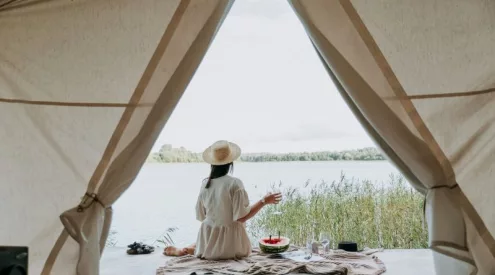Antarctica has always been right up there, top of my bucket list. So I jumped at the opportunity to join an expedition cruise to the last great wilderness with a party of travel journalists from around the world. We would set sail aboard L’Austral for the last continent on an auspicious date one hundred years after Scott reached the South Pole in mid-January 1911. Rendezvous Ushuaia, the main gateway for Antarctic expeditions and cruises, in Tierra del Fuego way down south of Argentina and Chile.
Flying down to Patagonia we descend over snowy peaks and the glaciers of El Calafate to the remote island runway at Del Fin del Mundo (the end of the world). Welcome to Ushuaia, “the southernmost town in the world” – it says so in a new stamp in my passport. Cruise liners depart from here for Antarctica during the short summer season. The midday temperature is surprisingly chilly for January – and all the tourists on board our Aerolineas Argentinas flight pull on anoraks and beanies.
With two days to kill waiting for our good ship to come in, we have plenty of time to look around the remote settlement of Ushuaia. Set in a spectacular landscape in an island archipelago off mainland Chile and Argentina, this town lives on tourism and fishing. During the short summer season many people end an overland trip through Argentina and Patagonia here. The main street is full of adventure shops, tour and souvenir shops. A hawker warmly dressed as a king penguin peddles soft toy penguins outside the tourist centre every day. It makes a change to giraffes and rhinos.
Strolling around Ushuaia, every name conveys an evocative sense of place. This remote region is called Tierra del Fuego (land of fire), home to world’s end lighthouse, the Del Fin del Mundo (end of the world) train, the Straits of Magellan, Cape Horn and the Beagle Channel where we will head out via the Drake Passage to the Antarctic. Every cape, peninsula and strait on my huge map is named after an early explorer.
It rains a lot in Ushuaia – which may explain why there are so many museums. You have to pack a brolly and an anorak for a walkabout. On a typical summer’s day of South Atlantic squalls, we visited the maritime museum set in the cells of the old frontier prison. The exhibits show how Ushuaia was established as a penal colony in the early 1900s – with cells devoted to all the expeditions to the Antarctic over the last three centuries, and one of the best collections of model tall ships in the world.
Generations of explorers rounded Cape Horn and visited Tierra del Fuego, from Captain Cook to Darwin. The land of fire was named after all the fires lit along the shores by the original inhabitants. We visited the fascinating Yamana museum which documents the culture of the vanished indigenous Indians of Tierra del Fuego – made legend by a missionary who wrote a book called – The Uttermost Part of the Earth.
The Tierra del Fuego National Park (63 000 ha) on the border of Argentina and Chile is a major drawcard with hiking trails around the coast of the Beagle Channel, lagoons and mountains. One of the most popular ways of getting there is on the Prisoner’s steam train to the end of the world – el tren del fin del mundo – on an old logging route built by convicts in 1910. On a coastal hike through the beech woods and peat bogs we saw many seabirds – but didn’t spot the Fuegian red fox, beavers, otters or guanacos (a wild red llama). We also did an amazing hike up the Martial glacier above Ushuaia which has a ski-lift and walking trail right to the ice at 1200m.
Tour operators also offer popular catamaran cruises through the Beagle Channel – named after Darwin’s pioneering ship – to see the sea lion, bird and penguin rookery islands as well as the lighthouse at the end of the world and Harberton Ranch. In winter you can visit a Siberian dog farm and dog sled ride or ski in the snow – but most tourists come here over the short summer season. Even in summer it gets cold and wet this far south at about 55o latitude (It’s a lot further south than Cape Town).
We stayed at Los Acebos Hotel on the slopes above town which offers amazing view of the Beagle Channel. Ushuaia has many backpackers, hostelries, guesthouses and hotels but it’s a noisy little port town full of hustle and stray dogs. We were delighted we were staying out of town, enjoying the views and fresh mountain air. Taxis around town are cheap with shuttles to destinations out of town like the tierra del fuego park.
We dined on the long restaurant row on main street – take your pick of traditional Argentinian asado (braai house), parilla (grill house), seafood, burritos and pizza. Ushuaia is famous for its sweet meaty spider crab from the Beagle Channel and squid and black hake from Patagonia. The region is also famous for its cool-climate wines.
Mesmerised by all the exotic wine labels I came across in the wine shop at the end of the world I stock red up on unfamiliar Argentinean wines made from old varieties such as Bonarda (red) and Torrontés (white) – as well as Malbec, the national grape of Argentina. When in Patagonia, you have to try the End of the World Pinot Noir. The most southerly wine route in Argentina, this region at parallel 39o South is renowned for its Pinot Noir and Merlot grown at low altitude in vineyards where Saurian fossils are often found. Patagonia is home to the world’s only wine and reptile fossil route!
There’s not much to do at night in Ushuaia so I caught up on my research. While rereading two classics – The Old Patagonian Express (Paul Theroux) and In Patagonia (Bruce Chatwin) – I came across references to one of the last boer treks, to Patagonia in 1903. Around Sarmiento you still find names like Venter, Visser, Vorster, Kruger and Botha in the local telephone directory – and I’m told Afrikaans is still spoken there. Howzit senor! There’s also a huge community of Welsh sheep farmers who came over in the mid-19th century – and settled the immigrant melting-pot of Argentina with Welsh names like Trelew, Trevelan, Gaiman and Madryn. So much more to see. I’d have to come back because I sail for the Antarctic tomorrow.
For expedition itineraries and fares of L’Austral and Compagnie du Ponant around the world, contact their agents in Johannesburg: Development Promotions – tel 011 442 0822 or go to www.devprom.co.za














